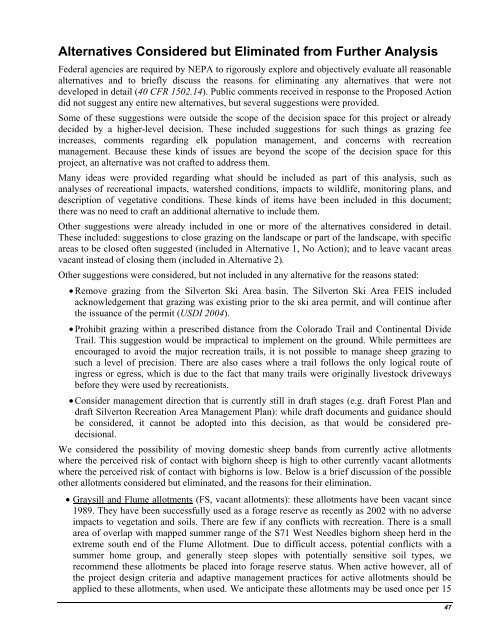NEPA--Environmental Assessment
NEPA--Environmental Assessment
NEPA--Environmental Assessment
You also want an ePaper? Increase the reach of your titles
YUMPU automatically turns print PDFs into web optimized ePapers that Google loves.
Alternatives Considered but Eliminated from Further Analysis<br />
Federal agencies are required by <strong>NEPA</strong> to rigorously explore and objectively evaluate all reasonable<br />
alternatives and to briefly discuss the reasons for eliminating any alternatives that were not<br />
developed in detail (40 CFR 1502.14). Public comments received in response to the Proposed Action<br />
did not suggest any entire new alternatives, but several suggestions were provided.<br />
Some of these suggestions were outside the scope of the decision space for this project or already<br />
decided by a higher-level decision. These included suggestions for such things as grazing fee<br />
increases, comments regarding elk population management, and concerns with recreation<br />
management. Because these kinds of issues are beyond the scope of the decision space for this<br />
project, an alternative was not crafted to address them.<br />
Many ideas were provided regarding what should be included as part of this analysis, such as<br />
analyses of recreational impacts, watershed conditions, impacts to wildlife, monitoring plans, and<br />
description of vegetative conditions. These kinds of items have been included in this document;<br />
there was no need to craft an additional alternative to include them.<br />
Other suggestions were already included in one or more of the alternatives considered in detail.<br />
These included: suggestions to close grazing on the landscape or part of the landscape, with specific<br />
areas to be closed often suggested (included in Alternative 1, No Action); and to leave vacant areas<br />
vacant instead of closing them (included in Alternative 2).<br />
Other suggestions were considered, but not included in any alternative for the reasons stated:<br />
• Remove grazing from the Silverton Ski Area basin. The Silverton Ski Area FEIS included<br />
acknowledgement that grazing was existing prior to the ski area permit, and will continue after<br />
the issuance of the permit (USDI 2004).<br />
• Prohibit grazing within a prescribed distance from the Colorado Trail and Continental Divide<br />
Trail. This suggestion would be impractical to implement on the ground. While permittees are<br />
encouraged to avoid the major recreation trails, it is not possible to manage sheep grazing to<br />
such a level of precision. There are also cases where a trail follows the only logical route of<br />
ingress or egress, which is due to the fact that many trails were originally livestock driveways<br />
before they were used by recreationists.<br />
• Consider management direction that is currently still in draft stages (e.g. draft Forest Plan and<br />
draft Silverton Recreation Area Management Plan): while draft documents and guidance should<br />
be considered, it cannot be adopted into this decision, as that would be considered predecisional.<br />
We considered the possibility of moving domestic sheep bands from currently active allotments<br />
where the perceived risk of contact with bighorn sheep is high to other currently vacant allotments<br />
where the perceived risk of contact with bighorns is low. Below is a brief discussion of the possible<br />
other allotments considered but eliminated, and the reasons for their elimination.<br />
• Graysill and Flume allotments (FS, vacant allotments): these allotments have been vacant since<br />
1989. They have been successfully used as a forage reserve as recently as 2002 with no adverse<br />
impacts to vegetation and soils. There are few if any conflicts with recreation. There is a small<br />
area of overlap with mapped summer range of the S71 West Needles bighorn sheep herd in the<br />
extreme south end of the Flume Allotment. Due to difficult access, potential conflicts with a<br />
summer home group, and generally steep slopes with potentially sensitive soil types, we<br />
recommend these allotments be placed into forage reserve status. When active however, all of<br />
the project design criteria and adaptive management practices for active allotments should be<br />
applied to these allotments, when used. We anticipate these allotments may be used once per 15<br />
47

















